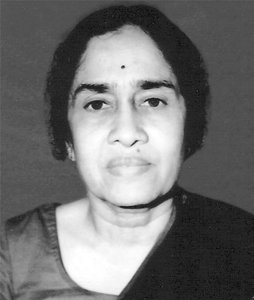Kamala Sohonie facts for kids
Quick facts for kids
Kamala Sohonie (कमला सोहनी)
|
|
|---|---|
 |
|
| Born | 8 June 1912 Indore, India
|
| Died | 28 June 1998 (aged 86) New Delhi, India
|
| Alma mater | Bombay University, Mumbai. Newnham College, University of Cambridge |
| Known for | Being the first Indian female to earn a PHD |
| Spouse(s) | M.V Sohonie |
| Scientific career | |
| Fields | Biochemistry scientist |
Kamala Sohonie (born June 8, 1912 – died June 28, 1998) was an amazing Indian biochemist. In 1939, she made history by becoming the first Indian woman to get a PhD in a science subject. Her journey to study at the Indian Institute of Science (IISc) in Bangalore was super important. It opened the doors for other women to be accepted into that famous institution for the very first time.
Kamala Sohonie's research looked into how vitamins affect our bodies. She also studied the nutritional value of common Indian foods like pulses (beans and lentils) and paddy (rice). She even researched a special palm extract called 'Neera'. This work was inspired by the then-President of India, Rajendra Prasad. For her great work on Neera, Kamala Sohonie received the Rashtrapati Award, which is a big honor!
Early Life and Challenges
Kamala Sohonie was born on June 8, 1912, in Indore, India. Her father and uncle were both chemists. They had studied at the Tata Institute of Sciences, which later became the Indian Institute of Science. Kamala followed in their footsteps. She earned her Bachelor of Science (BSc) degree in 1933 from Bombay University, studying Chemistry and Physics.
After her graduation, Kamala wanted to do research at the Indian Institute of Science. But the director, a famous scientist named Prof. C. V. Raman, turned her down. He believed women were not good enough for scientific research. Kamala didn't give up! She protested outside his office, a bit like a peaceful sit-in, which is called a 'satyagraha'. This convinced him to let her in, but with some tough rules:
- She would be on probation for the first year.
- She had to work late at night as told by her guide.
- She must not "spoil the environment" or be a "distraction" to the male researchers.
Kamala felt very insulted by these rules, but she agreed. This made her the first woman ever admitted to the institute in 1933. She later said, "Even though Raman was a great scientist, he was very narrow-minded. I can never forget how he treated me just because I was a woman. The unfairness against women was so bad back then. What can you expect if even a Nobel Prize winner acts this way?" Luckily, after her first year, many more women were allowed to join the institution.
Career and Important Discoveries
At the IISc, Kamala's mentor was Sri Srinivasayya. She focused on studying proteins found in milk, pulses, and legumes. This research was especially important for India. Her hard work and scientific skills impressed Prof. Raman. A year after she finished her Master of Science (MSc) degree with honors in 1936, he finally allowed other women to join the IISc.
Next, Kamala was invited to Cambridge University in the UK. She worked in a famous lab and studied plant tissues. She made an amazing discovery while working on potatoes: she found an enzyme called 'Cytochrome C'. This enzyme is super important for how plants, humans, and animals create energy! Her PhD thesis on this discovery was only 40 pages long, which was much shorter than most PhD papers. She finished it in just 14 months!
After getting her PhD, Kamala returned to India in 1939. She was a supporter of Mahatma Gandhi and wanted to help her country. She became a Professor and Head of the Biochemistry Department at Lady Hardinge Medical College in New Delhi. Later, she worked at the Nutrition Research Laboratory, studying the effects of vitamins.
In 1947, she married M.V. Sohonie and moved to Mumbai. She joined the Royal Institute of Science as a Professor of Biochemistry. There, she continued her research on the nutritional value of legumes. It's believed that she had to wait four extra years to become the Director of the Institute because of unfair treatment against women in science. During this time, Kamala and her students did important research on foods eaten by people who were not well-off in India.
Kamala also started studying 'Neera', a sweet sap from palm trees. This project came from a suggestion by India's President, Rajendra Prasad. She found that Neera had a lot of Vitamin A, Vitamin C, and iron. She also discovered that these important nutrients stayed in the Neera even when it was made into palm jaggery (a type of sugar) and molasses.
Later studies showed that giving Neera to malnourished children and pregnant women from tribal communities helped improve their health a lot. It was an inexpensive way to add nutrients to their diet. For this valuable work, Kamala Sohonie received the Rashtrapati Award.
Later Life and Legacy
Kamala Sohonie was an active member of the Consumer Guidance Society of India (CGSI). She was even elected President of the CGSI from 1982 to 1983. She also wrote articles about keeping consumers safe for the society's magazine, 'Keemat'.
Kamala Sohonie passed away in 1998. She collapsed during a ceremony held by the Indian Council of Medical Research (ICMR) in New Delhi, where she was being honored for her contributions. Her life showed incredible dedication to science and a strong spirit in overcoming challenges, paving the way for many women in India.
See also
 In Spanish: Kamala Sohonie para niños
In Spanish: Kamala Sohonie para niños 

